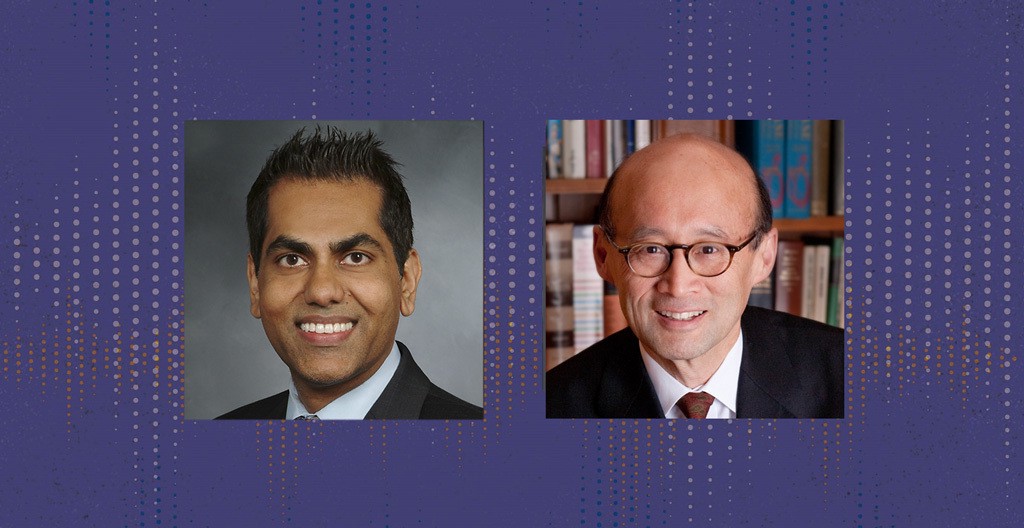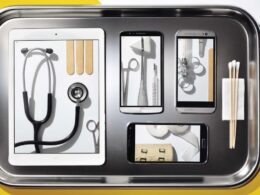NEJM Catalyst
With Rahul Sharma, MD, MBA, FACEP & Thomas H. Lee, MD, MSc
September 3, 2021
Physicians are responsible for making patients feel safe and secure, whether that’s in-person or via a screen.
Thomas H. Lee, MD, MSc, interviews Rahul Sharma, MD, MBA, FACEP, Professor and Chairman of the Department of Emergency Medicine at Weill Cornell Medicine and Founder and Executive Director of Weill Cornell Medicine’s Center for Virtual Care.
Summary
The Founder and Executive Director of the Center for Virtual Care at Weill Cornell Medicine describes the school’s telemedicine training curriculum for students and faculty and why their students feel a step ahead of those at other medical schools.
TOM LEE: This is Tom Lee, Editor-in-Chief of NEJM Catalyst. We’re talking about training the next generation of physicians on how to deliver telemedicine. Our expert is Rahul Sharma, a national leader in both emergency medicine and telemedicine. He also knows a lot about how those two should be integrated. Rahul has many titles, but I’ll just note that he’s Chair of the Department of Emergency Medicine at Weill Cornell Medical College in New York City, and he’s the Founder and Executive Director of the Center for Virtual Care there as well. He’s played important roles in defining how virtualists should practice and now is actively teaching the next generation.
Rahul, I was intrigued when you recently told me that Weill Cornell had integrated telemedicine into the medical school curriculum, and in fact, made it a requirement. Can you tell us the nature of this module?
Rahul Sharma: Sure, Tom. Here at Weill Cornell Medicine, our emergency medicine physicians, our faculty members, alongside the Center for Virtual Care, we’ve been teaching telemedicine to Weill Cornell medical students since January of 2019.
Weill Cornell Medicine, the medical college, has about 110 students each year, and [requires students to take an] emergency medicine clerkship in their major clinical year.
The leadership of our clerkship partnered with our telemedicine faculty to deliver the core knowledge in telemedicine skills during the rotation.
- Prior to starting their clinical years, the medical students receive an introduction to telemedicine as part of their transition to the clerkships course.
- Then, as part of this new clerkship, students take a 4-hour course in advanced communication skills and physical diagnosis via a video-based platform.
This course is led by three faculty from our department who have experience in medical education, but who are also clinical providers in telemedicine.
To date, we’ve trained over 200 medical students at Weill Cornell through our course.
We used to teach proper bedside manner; it’s now equally important for physicians to learn “web-side” manner.
LEE: As you know, I am practicing as a primary care physician in Boston. When Covid-19 hit in March 2020, I immediately converted virtually all of my patients via telephone or Zoom. I didn’t get any special training, and I get the feeling that maybe I should have.
SHARMA: What you’re experiencing is what many physicians and providers have been experiencing during the pandemic.
Physicians have historically trained only to deal with patients in person, but that’s no longer practical in today’s health care landscape.
We used to teach proper bedside manner; it’s now equally important for physicians to learn “web-side” manner.
Think of it like this: you would never have a medical student perform a physical exam, do history-taking, without knowing the dos and don’ts.
They usually get a course in physical diagnosis, history-taking.
It should be the same with telemedicine. Physicians don’t always realize how much of the patient encounters [are shaped] before we even perform the physical exam.
In this virtual world, we, the physicians, are responsible for setting the stage and creating an environment that allows the patient to feel safe and secure.
The need for telemedicine has grown exponentially over the last 2 years, largely due to the Covid-19 pandemic, but even before the pandemic we start to see the shift toward telemedicine.
Our setup for virtual care has been at the forefront for offering training and simulations for clinicians who want to improve their telemedicine skills.
This started going on before the pandemic even started.
Over the last 3 years, we trained almost 600 learners, including medical students, residents, patient navigators, physicians, and our own faculty.
LEE: Before we get into what you’ve included in the curriculum for those students and faculty, can you tick off a few of the most common glaring errors that you see clinicians, who have not had training, commit?
SHARMA: Physicians and clinical providers are responsible for creating a safe personal connection with the patients through a screen, and not all of them have the skill set to do so. Some of the most common errors that we found were, number one, not looking at the camera, poor eye contact.
That is a big part of the patient-physician-provider interaction. Not knowing, how do you translate empathy over a video screen? Is that even possible? Having poor nonverbal communication. And just being unfamiliar with examining patients in a virtual space.
When this pandemic started, people thought it was easy, but I will tell you that doing a virtual visit, telemedicine visit, with a patient is not the same as Facetiming with your grandparents or your friend.
There is a skill set that you need to do this.
LEE: Those groaning noises in the background were me recognizing myself in your description: not looking up at the camera, fumbling around, trying to improvise an examination.
A virtual visit, telemedicine visit, with a patient is not the same as Facetiming with your grandparents or your friend. There is a skill set that you need to do this.
To help people like me, how do you teach what you teach to faculty and students?
SHARMA:
- Our curriculum includes using multiple formats to teach professional verbal and nonverbal techniques employed over video and exploring differences and similarities between in-person as well as telemedicine care.
- We utilize simulation to teach the face-to-face skills required to convey good bedside manner: verbal and nonverbal communication, professionalism, warmth, and empathy.
- These are things that you could practice, and using simulation and simulated patients, actors, has shown to be extremely beneficial.
- Also, we teach physical exam skills. I was a believer that there’s no way you could do a physical exam unless you touch the person, or you’re next to the person, but we’ve learned, over the last several years, that physical exam skills can be taught and assessed using simulation techniques and practice, and having the patient help you do the exam.
- We use tabletop exercises or small group exercises to promote a collaborative learning environment.
And we minimize the number of didacted lectures.
We do have some lectures, but this is a hands-on, supportive learning environment rather than making [students] sit through a bunch of traditional lectures.
LEE: If I were to ask one of your students who finished the module what they have learned, what do you think the top two or three things they would say might be?
SHARMA: I think they would say that they’ve learned on-camera etiquette, setting the stage, and how to connect effectively to the patient including the lighting, presentation, and the body language.
They’ll tell you that they learned about verbal and nonverbal communication skills, especially during history-taking.
When you look at a patient, looking at how they’re acting, whether they’re smiling or wincing.
Those give you a lot of clues, especially when you’re doing history-taking over a video camera.
Students will tell you that they were taught how to appropriately conduct a basic physical exam, virtually.
As I said earlier, I didn’t think that was possible, but from numerous cases, we’ve learned that you could do a detailed physical exam virtually by having the patients assist you.
One of the most important things that students learn is how to best prepare to overcome any technical challenges they may face during a telemedicine encounter.
I’m a firm believer in Murphy’s Law.
If you don’t plan, things will go wrong, and frequently you do have technical issues. For example, the camera goes off.
How do you deal with those issues?
That’s something that you have to prepare for, otherwise your encounter with the patient could be negatively impacted.
Telemedicine is medicine. It’s not a different type of medicine. It is medicine.
LEE: Any sense of how it’s going? How have students responded?
SHARMA: So far, the response has been overwhelmingly positive. The one thing that I want to reinforce, and that our telemedicine course reinforces, is that telemedicine is medicine. It’s not a different type of medicine. It is medicine.
Many of the students have found that the sessions have helped provide insight into their communication, history-taking, and physical exam skills.
We’ve had students say they feel that they’re a step ahead of students at other medical schools because they’ve gotten this training in telemedicine.
In a study we conducted to help develop the curriculum, 97% of our learners who participated in the courses found them useful, 100% felt that simulation was an effective teaching strategy, and over 90% of our students perceived an improvement in their comfort and ability to perform video-based exams.
It’s been nice to see this feedback and to see the students are engaged and enjoying this experience.
LEE: It won’t be surprising if the students who have given attention to communication in this course improve with their in-person communication, too, since they are going to be thinking about excellence in communication, in general.
It’s awfully early, and I’m sure you’re going to get better and better at figuring out what should we be doing and how we should be teaching it, but I’m glad that you started this important work. We look forward to hearing more from you on this and other topics in the years ahead.
My pleasure, Tom. Thank you, very much, for having me.
Rahul Sharma, MD, MBA, FACEP
- Professor and Chairman, Department of Emergency Medicine, Weill Cornell Medicine, New York, New York, USA; Founder and Executive Director, Center for Virtual Care, Weill Cornell Medicine, New York, New York, USA; Emergency Physician-in-Chief, NewYork-Presbyterian/Weill Cornell Medical Center, New York, New York, USA
Thomas H. Lee, MD, MSc
- Editor-in-Chief, NEJM Catalyst Innovations in Care Delivery; Co-Chair, NEJM Catalyst Editorial Board; Chief Medical Officer, Press Ganey Associates, Inc., Boston, Massachusetts, USA; Member, Editorial Board, New England Journal of Medicine
Originally published at https://catalyst.nejm.org on September 3, 2021.
TAGS: Telemedicine; Virtual Care












